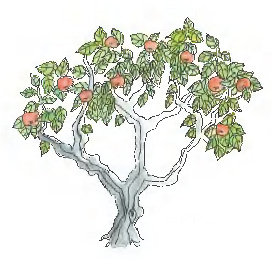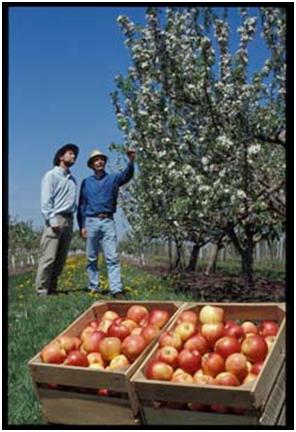
Apples and autumn—the two go together. Turning leaves, cool evening, apples in the roadside stands—all are sure signs of fall. For many Minnesotans, heading to the orchard to harvest apples has become an autumn tradition. Savoring apple pie and hot apple cider seem even more enjoyable when days are crisp. Fortunately, apples can be enjoyed year ‘round. Here in Minnesota, we are lucky to have a large selection of apple varieties that can be grown around the state. Many of them were developed locally at the University of Minnesota.
Initially the winters made Minnesota a difficult place to grow apples, because the trees could not survive the harsh climate. However, due to the persistence of the early pioneer and farmer, the colorful and eccentric Peter M. Gideon, a winter-hardy variety was discovered. Gideon worked for fifteen years, growing thousands of seedlings near Lake Minnetonka, before finding a consistent winter survivor in 1868. He named the apple ‘Wealthy’ after his wife. By the early twentieth century, the Wealthy was one of the top five apples grown nationally and is still grown today. In addition, the success of the Wealthy fueled the quest for more Minnesota apples of excellent quality, giving others the incentive to continue the work Gideon had started.
The University of Minnesota purchased its current location in Chanhassen in 1908, thereby officially establishing its breeding program. In 1922, the program released its first apple variety, the still popular Haralson. DNA testing has shown that Wealthy, Gideon’s introduction, is its likely parent.
Today, only one of three fruit breeding programs in the country, the University of Minnesota has become known for producing hardy fruit varieties. To date, the U has introduced 26 apple varieties, including Fireside in 1943, Sweet Sixteen in 1978, the very popular Honeycrisp in 1991, and the newest SweeTango®. Because of this extensive program of research and development, orchards have a broad range of apples to plant. Fruit varieties developed here, including Regent, Prairie Spy, Beacon, and Red Baron, now represent three fourths of the state’s fruit production.
With over 5 million trees planted worldwide, the Honeycrisp is the University’s most successful introduction to date. Known in Europe as Honeycrunch, the apple is good for home gardens or commercial operations. It sells well because it is explosively crisp and has a sweet-tart taste and has excellent storage qualities.

In 2006 the development of Honeycrisp was selected as one of the top 25 innovations of the decade by the Better World Report. Prepared by the Association of Technology Managers, the report recognized academic research and technology applications that have improved our way of life. In the award the report noted that Honeycrisp with “its almost magical properties” helped revive a shrinking apple industry. In Minnesota more than 40 million Honeycrisp are produced each year.
Apples are a $14 million dollar industry in Minnesota. The state has commercial apple orchards in 78 of its 87 counties, producing nearly 16 million pounds of fruit (about 19, 4003,000 bushels) annually. Over 330,600 acres are planted in apples. There are more than 115 retail orchards throughout the state, selling a distinctive assortment of apple varieties.
Developing new varieties is a long, demanding process. From the seedlings they have chosen as superior, breeders will take two buds and graft them onto dwarf rootstock. Using dwarf rootstock speeds the process because these trees produce normal size fruit in 4 to 5 years, not the 7 to 10 of a full sized tree. Additionally, dwarf trees save valuable space in the orchard, a real consideration when thousands of trees are grown.
Many will be culled as juveniles when they exhibit diseases, winter injury, or other problems. Only about 1 to 2% of the seedlings will be selected for further testing. Once saved, each plant is given a number, such as MN 1523, a designation it will retain until it is discarded or eventually named and introduced as a new variety.
Once the tree begins producing fruit, tasters will test the apples—about 500 a day– for flavor and texture and observe them for appearance. From the initial quantity, 2000 to 3000 trees are discarded in their first year because they do not produce fruit that is unique. Those that pass the initial testing are thoroughly evaluated by numerous panels for 25 different characteristics. Overall, about 1 in every 20,000 of these different apples tested is named and released to the public.
The process of patenting and releasing the budded trees to growers, increasing production and getting the fruit into the marketplace takes about 15 more years. The Honeycrisp apple, which has become well known in recent years, was actually released in 1991; the cross was made in the 1960s, making this variety technically about 50 years old. Now Honeycrisp is the #1 apple in Minnesota, the #5 apple nationwide.
The apple was chosen as one of the 10 Plants that Changed Minnesota because of the great impact it has had on Minnesota. Apples were the number 1 plant nominated by the public when nominations were called for in the spring of 2012. Nominators cited the health benefits of apples, their economic impact on the state, and the importance of apple research spearheaded by the University of Minnesota. Apples promote health, beauty, and a true sense of community within the state.
Nutrition Information
An apple a day may not keep the doctor away, but it will certainly benefit your health. Apples are a refreshing snack that is low in calories, but high in dietary fiber. They contain an impressive list of antioxidants and are a good source of vitamins A and C and the B-complex vitamins. They are fat, sodium, and cholesterol free!
Don’t peel your apples. Most of the fiber and many of the antioxidants are in the skin.
Research suggests that they may reduce the risk of colon, prostate, and lung cancer.
A medium-sized apple with its skin has about 81 calories, 4 grams of fiber, and 21 grams of carbohydrates.
Did You Know?
- The scientific name for apple is ;Malus domestica.
- Apples are members of the rose family.
- Archeologists have found evidence that humans have been eating apples since at least 6500 B.C.
- Pilgrims planted the 1st apples in America in the Massachusetts Bay Colony.
- The average American eats 19 lbs. of apples a year.
- The largest apple ever picked was 3 lbs. 2 oz.
- Most apples are hand-harvested to this day.
- It takes the energy of 50 leaves to produce one apple.
- The science of apple growing is called pomology, from the Latin “pomum” meaning fruit.
- The number five is important in “apple world.” An apple blossom has five petals; apple blossoms typically form in clusters of five, and each apple has five seed cavities, making the star you see when the apple is cut in half.
- The apple is the state fruit of Minnesota, as well as Washington, Illinois, Vermont, West Virginia, New York, and Rhode Island.
For more information see the 10 Plants That Changed Minnesota MSHS book.